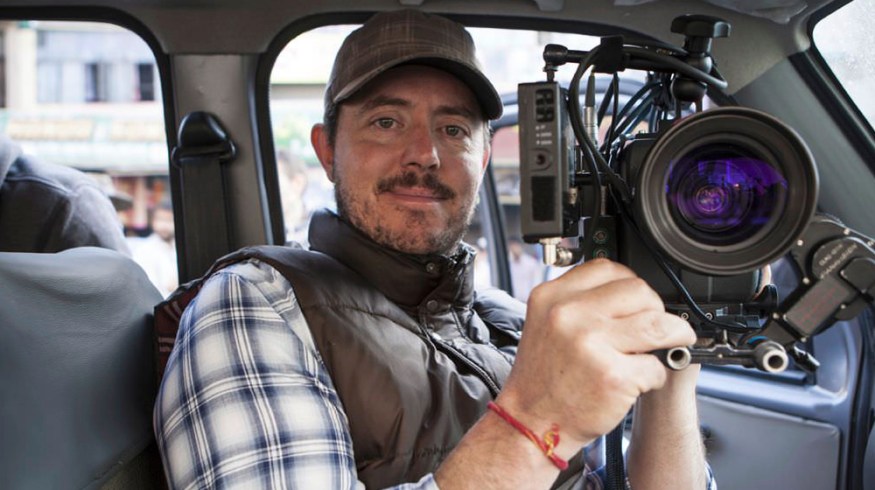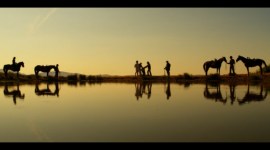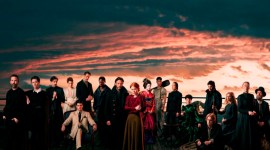
Frontier Man: Cinematographer Greig Fraser
Greig Fraser doesn’t see problems, just opportunities. We track his rise to the top and his journey on the frontier of cinematography.
Few cinematographers manage to cross over into the public consciousness, but maybe Greig Fraser is one of those. It helps that the movies he’s worked on recently, like Dune and The Batman, have been massive crowd-pleasers.
Don’t forget that his work on these films and others has given each movie a look that wraps it up ready for viewing. Dune was “epic,” while The Batman was “filthy noir.”
But, more than the public reaction to his skills is what he’s doing behind-the-scenes. He’s well-known in the industry as somebody who pushes the envelope and rides on the edge of technological advances, as we’ll chronicle in this “career so far” profile.
As for awards, this year could be his best yet. He’s already been awarded Best Cinematography for Dune by BAFTA and is nominated for the Oscar.
Perhaps it’s a shame that The Batman was so delayed that it didn’t fall into a nomination gap. I’m sure the filmmakers aren’t too upset as that film is well on its way to $1 billion in returns.
But, how did Fraser get to this exalted position? Was it just luck as the films he’s been a part of have been wildly popular, or does he deserve all the praise?
Zero Light
When you first talk with Fraser, you find him quite sure of himself. But, this isn’t any flavor of ego—he doesn’t seem to be hindered by that. When he talks about how he has shot something, he always supports his hunches, albeit educated hunches.
When he shot Zero Dark Thirty back in 2012, there was no LED volume available as with The Mandalorian and The Batman. If you wanted the high sun and black nights, you had to go to places like Jordan.
If you remember the film, it was the description of the intelligence and final Navy SEAL raid on Osama bin Laden’s fortified compound. For the final twenty-five minutes of the movie—the raid—Fraser was working in near-total darkness.
Unknown to the viewing public, there was soft pressure for Fraser to use Sony’s new F65 camera as it was a Sony film. Not one to bow to such pressure, Fraser decided not to use a new camera in such harsh conditions, but to use a camera that had proved its reliability—ARRI’s ALEXA.
However, the worry was that he was just about to shoot a large part of the film without any lights on a pitch-black night—he did rig some very high softboxes, which he hoped would shine down some “starlight.”
The scenes were also heavy with the green light from the seal’s night vision scopes, so the night’s darkness was effectively the contrast to that. It had to be dark for the difference to work.

The answer was to be able to check as he had shot, preferably on the day he had shot it. For this to happen, a digital film lab was set up in a nearby hotel room. Back in 2012, facilities like digital labs were just appearing as RAW was being used more to shoot.
But in Jordan at that time, the subject of the film made the security of the crew paramount. Luckily, the existence of the lab was never divulged and it became hugely important in the success of Fraser’s and director Kathryn Bigelow‘s vision for the movie.
We pushed it right to the edge but, again, having the lab there looking at the images showed me where my limits were. But, there were shots that didn’t work. I won’t tell which ones they are. Not seeing noise or not seeing grain is just a new consciousness.
– Cinematographer Greig Fraser
Interestingly, Fraser has said that if he hadn’t had the digital lab at his disposal, he wouldn’t have been so adventurous with his shooting.
I probably would have been a little safer, a little bit more predictable.
– Cinematographer Greig Fraser
His hunch about using a lab and the ARRI camera paid off. This assuredness was a pattern in the way he worked in pre-production as well as on set.
Going Rogue
Two years later, Fraser was to shoot one of the new Star Wars orphan movies, the ones that weren’t part of the series. Rogue One: A Star Wars Story was an immediate prequel to Star Wars: Episode IV – A New Hope.
But, because it wasn’t part of the series, it was allowed to have a darker tone and dispensed with the Starwarsian screen wipes and opening text scrawl.
The movie definitely had a sense of darkness and gray morality, which was brave of Disney and Lucasfilm.
There was a fair amount riding on the concept of these separate story films, yet also some freedom for the image-makers. Fraser had, of course, been a huge Star Wars fan in his youth so he wanted to add something special to this incredible opportunity.
At the start of pre-production, he threw a spanner in the works for the producers and director to chew on. He had recently heard about a new camera from ARRI called the ALEXA 65. The sensor was as big as a 65mm film frame and was made up of single ALEXA sensors to push digital cinematography into IMAX and large-scale theaters.
But, the compromises were many and, for Fraser, not insurmountable. First off, the Alexa 65 hadn’t been used for an entire film before, something he was considering for Rogue One as the camera. It had been used on a Mission: Impossible scene, but for most people with that size of the sensor, it was only thought of for shooting background plates.
Also, it would only shoot 29fps and could only record footage on 512GB mags, which for its data rate represented twelve minutes of footage.
Fraser saw beyond those problems and countered the producer’s wish to use film by saying that 1000ft film mags only contain ten minutes of footage.

He pushed for its use for the whole production.
We tested the ALEXA 65 with other lenses just to make sure that we liked the look of it. Then, I went to LA and shot some film tests with some of the anamorphic lenses which are coming down the pipe.
I thought the lenses were fantastic, but they weren’t all appropriate to us as we knew that we wanted to do a run-and-gun-type film. We wanted to keep our camera loose.
We had some Technocrane stuff and some dolly stuff for sure, but for the most part, we needed a loose camera. This was decided from discussions with the director quite early on. The default camera position became handheld.
– Cinematographer Greig Fraser
Rogue One was also the movie that turned Fraser on to LED lighting. Up to that point, LEDs were mostly being used for eye lights, augmentation, and as strips of lights. The new types of LED coming out around that time meant that he could dispense with gels and use the RGB palettes on the LEDs.
When I did the camera tests, I did lighting tests, as well, and found we could absolutely light this entire movie with just Digital Sputniks as the main lighting source.
– Cinematographer Greig Fraser
Rogue One did turn out to be an expensive film to make with quite a few re-shoots, but it grossed over $1 billion worldwide and was the template for all the other Star Wars Story films coming down the line.
In fact, DOP Bradford Young, who subsequently shot Solo, made a point of coming to the set of Rogue One to see how Fraser was shooting it.
The Mandalorian and Dune
Fraser has trust in his eye as all the notable DOPs do. But, his is also an experimental eye, and mixed with his free-thinking mind, had thrown up some truly amazing ideas.
For instance, on Rogue One, he dealt with the large projection screens for X-wing, Death Star, and Millennium Falcon scenes as a major step forward in filmmaking. Avoiding the blue screen and the months of post-production that it represented meant that his camera was shooting final pixels in a space adventure.
So, it was no surprise to see final pixels with VFX and huge vistas as backgrounds turning up again in The Mandalorian.
The big difference this time was the addition of a game engine to enable the movement of the screen footage and also the parallax when tracking the camera moves. When Fraser was visually fooled by doing some handheld tests, he knew the concept would work. “We were off to the races,” he said.
He also saw how the LED volume became another light source with its curved screens surrounding the actors.
The Mandalorian was definitely a test case for LED volumes and now many studios are benefiting from the work Fraser started back on Rogue One and was perfecting on the TV show.
Dune, however, was totally different.
This was to be filmmaking on the largest scale with IMAX employed to try and restart the cinema business from the trough of the pandemic. There were no LED volumes, but Fraser and crew went back to Jordan, which was a substitute for Dune.
Again, there were experiments and Fraser found a willing partner in his director Denis Villeneuve. Their hunt for the aesthetic for this epic adventure involved shooting in a digital large format, then transferring that image onto 35mm film, which would then be re-scanned to digital for delivery.
You get the feeling that Fraser was pushing Villeneuve to go further and to mix the analog of the film with the pristine sheen of digital.
Back to the Dark with The Batman
If you’ve seen The Batman, then you know that it’s all levels and meanings of the word dark. For Fraser, it was a hugely challenging way of balancing the noir comic book idea of Batman with shooting a whole movie this way and, at the same time, satisfying an extremely vocal fan base.
His seemingly strange idea was to use dark images that were easy to see. He even made a look-book for his director Matt Reeves.
However, the real skill was to control the darkness, yet still place pockets of light in every frame. Re-watch the film with that in mind and be blown away at the skill involved.
There was also the return of the LED volume for certain rooftop scenes in Gotham City and a reduced camera technique that supplemented actor Robert Pattinson‘s “gliding” gait that he had decided on for the caped crusader.
At the moment, Fraser has rejoined his Rogue One director Gareth Edwards on the movie True Love, another science fiction tale. But, after that, Dune 2 awaits.
Cover image via IMDb.





